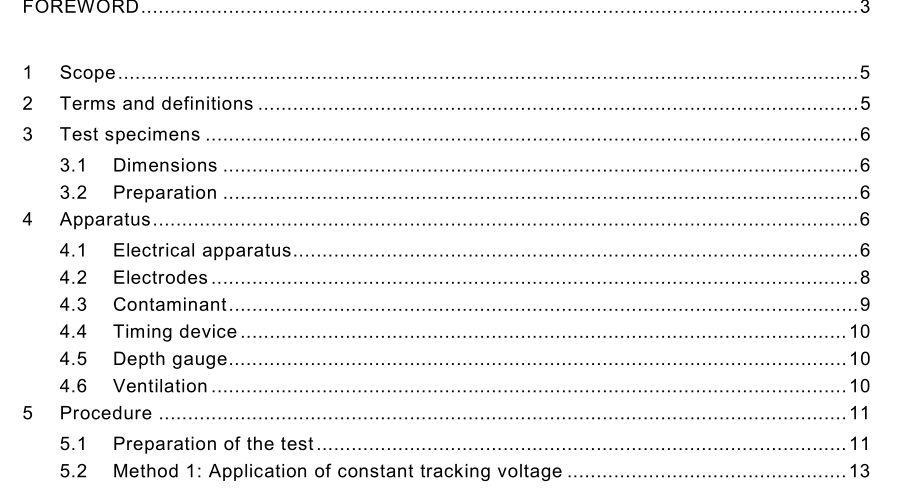IEC 60587-2007 pdf Electrical insulating materials used under severe ambient conditions – Test methods for evaluating resistance to tracking and erosion

5.3 Method 2: stepwise tracking voltage Select a starting voltage, being a multiple of 250 V, such that failure according to criterion A of 5.4 (current exceeding 60 mA) does not occur sooner than the third voltage step (a preliminary trial test may be necessary). With the contaminant flowing uniformly at the specified rate, switch on and raise the voltage to the selected value. Maintain this voltage for 1 h and increase the voltage by a step of 250 V for each subsequent hour until failure by criterion A is recorded. As the voltage is increased the contaminant flow rate and the resistance value of the series resistor are increased according to Table 1 . The stepwise tracking voltage is the highest voltage withstood by all five specimens for 1 h without failure. Classification of the material is as follows: Class 2A x or 2B x, where x is the highest voltage, in kilovolts, withstood by the material under test. NOTE 1 Effective scintillation is essential and if not obtained, the electrical circuit, the contaminant flow characteristics and contaminant resistivity should be carefully checked. Scintillation means the existence of small yellow to white (with some materials occasionally blue) arcs just above the teeth of the lower electrode, within a few minutes of application of the voltage. These discharges should occur in an essentially continuous manner, although they may jump from one tooth to another. These discharges will burn away the specimen surface and may ultimately lead to tracking failure. Discharges which move rapidly over the surface between the two electrodes are not likely to produce tracks. The condition of effective scintillation may also be observed with a cathode-ray oscilloscope. The signal may be picked up across a resistor (e.g. 330 Ω, 2 W) placed in series with the overcurrent device. Proper scintillation is observed as a continual, but non-uniform, break-up of the power frequency current wave during each half cycle.
- ISO IEC 27050-4-2021 pdf Information technology — Electronic discovery — Part 4: Technical readiness
- ISO IEC 27036-1-2021 pdf Cybersecurity — Supplier relationships — Part 1: Overview and concepts
- ISO IEC 27013-2021 pdf Information security, cybersecurity and privacy protection — Guidance on the integrated implementation of ISO/IEC 27001 and ISO/IEC 20000-1
- ISO IEC 26580-2021 pdf Software and systems engineering — Methods and tools for the feature- based approach to software and systems product line engineering
- ISO IEC 24735-2021 pdf Information technology — Office equipment — Method for measuring digital copying productivity
- ISO IEC 24711-2021 pdf Information technology — Office equipment — Method for the determination of ink cartridge yield for colour inkjet printers and multi- function devices that contain printer components
- ISO IEC 23544-2021 pdf Information Technology — Data centres — Application Platform Energy Effectiveness (APEE)
- ISO IEC 23510-2021 pdf Information technology — 3D printing and scanning — Framework for an Additive Manufacturing Service Platform (AMSP)
- ISO IEC 23127-1-2021 pdf Information technology — Learning, education, and training — Metadata for facilitators of online learning — Part 1: Framework
- ISO IEC 23126-2021 pdf Information technology for learning, education and training — Ubiquitous learning resource organization and description framework
- IEC 63002-2021 pdf Interoperability specifications and communication method for external power supplies used with computing and consumer electronics devices
- IEC 60299-2014 pdf Household electric blankets – methods for measuring performance
- IEC 60086-3-2021 pdf Primary batteries – Part 3: Watch batteries
- AS IEC 60601.2.22-2014 pdf Medical electrical equipment Part 2.22: Particular requirements for basic safety and essential performance of surgical, cosmetic, therapeutic and diagnostic laser equipment
- IEC 60205-2009 pdf Calculation of the effective parameters of magnetic piece parts
- BS ISO IEC 15420-2009 pdf Information technology一 Automatic identification and data capture techniques EAN/UPC bar code symbology specification
- BS ISO IEC 19762.5-2008 pdf Information technology一 Automatic identification and data capture (AIDC) techniques – Harmonized vocabulary Part 5: Locating systems
- BS IEC 60860-2014 pdf Radiation protection instrumentation一 Warning equipment for criticality accidents
- ISO IEC 24735-2021 pdf Information technology — Office equipment — Method for measuring digital copying productivity
- ISO IEC 24711-2021 pdf Information technology — Office equipment — Method for the determination of ink cartridge yield for colour inkjet printers and multi- function devices that contain printer components